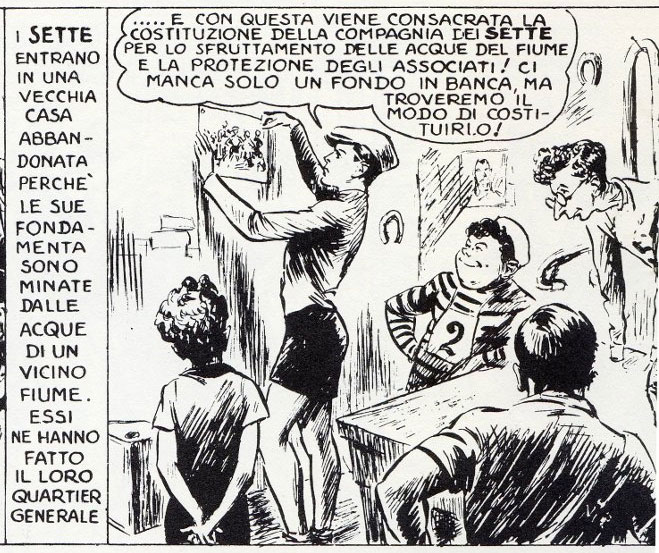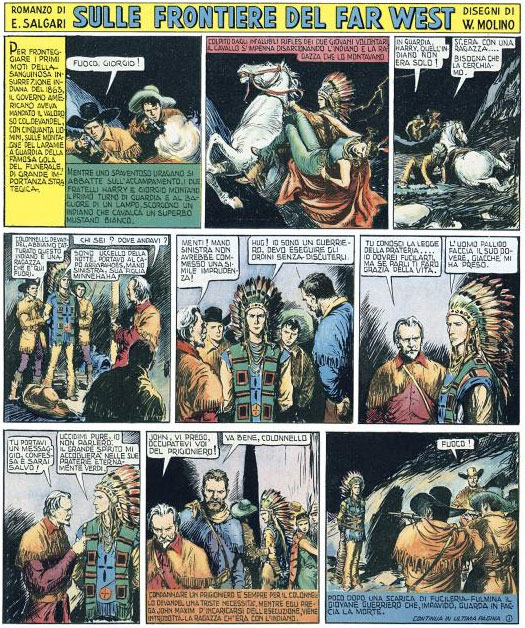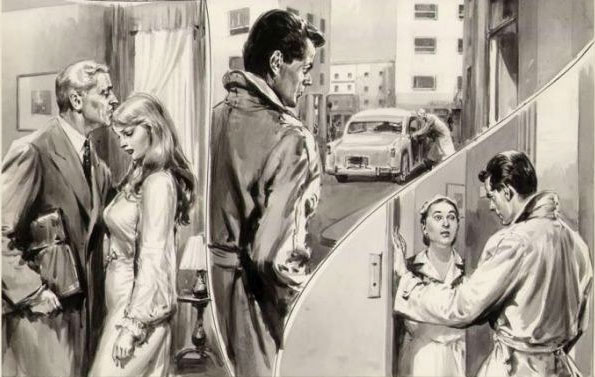Cover illustration for La Domenica del Corriere, 17 February 1957.
Walter Molino was an Italian comic artist and illustrator, notorious for his sensational cover paintings for the weekly Domenica del Corriere, that depicted mayhem and disaster in everyday situations. His illustrations for the women's weekly Grand Hotel popularized the "cineromanzi" genre, in which the lead characters of picture stories were based on popular film stars. Prior to this, Molino worked for Italy's pre-war comic magazines, most notably co-creating the serials 'Virus, il Mago della Foresta Morta' (1939-1940) and 'Captain l'Audace' (1939) with writer Federico Pedrocchi.
Early life and career
Walter Molino was born in 1915 in Reggio Emilia, a city in northern Italy. He inherited his lifelong passion for painting from his father. At age 15, the Molino family moved to Milan, where Walter enrolled at the Liceo Classico Berchet classical high school. Among his fellow students were the future film directors Luciano Emmer and Dino Risi. In 1934, Molino's satirical-political drawings in the student newspaper Libro e Moschetto were noted by Benito Mussolini and the young cartoonist was invited to make satirical drawings for Il Popolo d'Italia, the newspaper of the Fascist Party. In the following year, his art began appearing in the comic magazines published by Domenico and Cino Del Duca's Casa Editrice Universo: Il Monello, Intrepido and Il Giovinetto.
Universo magazines
The weekly Intrepido ran Molino's serials 'Il Cavaliere delle Nevi' ("The Knight of the Snow", 1935), 'Il Mozzo' ("The Hub", 1936), 'Il Piccolo Ammiraglio' ("The Little Admiral", 1937) and 'L'Affondatore degli Oceani' ("The Sinker of the Oceans", 1938). Simultaneously, he illustrated 'Giovinetto Eroico' ("Heroic Little Giovanni", 1935-1936), 'Il Piccolo Dubat' ("The Little Dubat", 1936) and 'Il Piccolo Patriota' ("The Little Patriot", 1936) in Il Monello. In 1936 and 1937, the latter story was continued in Del Duca's short-lived magazine Il Giovinetto. Molino also supplied the Del Duca magazines with both cover and interior illustrations.
Comics and cartoons in the 1930s
Walter Molino's workload quickly expanded in the second half of the 1930s, when he worked on advertisements, illustrations and satirical cartoons as well. His illustrations appeared in Modellina, the children's supplement of Modella magazine, the short-lived news weekly Il Milione (1939) and the satirical humor magazine Marc'Aurelio. Between 1936 and 1941, he made saucy cartoons with provocative pin-ups for the humor magazine Bertoldo (1936-1943) of the Rizzoli publishing house. In 1936-1937, Molino's art appeared in the children's magazine Il Saladino, the first magazine declaring itself entirely Italian. Enrico De Seta's Argentovivo! (1936-1937), a supplement of the Roman weekly La Tribuna Illlustrata, opened its pages exclusively to Italian creators. In 1937, Molino contributed the serials 'Dove Svolazza il Farfallefante' ("Where the Butterfly fFutters"), 'Terra Ardente' ("Burning Earth"), 'Tarzan' and 'Buddy Ebsen' to Argentovivo!. Mussolini's ban on American comics (except 'Mickey Mouse') in 1938 meant even more opportunities for domestic comic creators.
'La Compagnia dei Sette'.
Mondadori serials
In 1937, Walter Molino began his collaboration with the publisher Arnoldo Mondadori, who was then still operating under the banner Anonima Periodici Italiana (API). Molino's first serial was 'Zorro della Metropoli' ("Metropolis Zorro", 1937), about a masked vigilante leading a revolt against a vicious landowner in a small western village. Although serialized in Paperino, Mondadori's new magazine named after Walt Disney's Donald Duck, Molino's feature predated Disney's Zorro and was not related to this American pulp hero. The scriptwriter was Cesare Zavattini, with whom Molino also made 'La Compagnia dei Sette' ("The Company of the Seven"), published in the 1938 and 1939 volumes of the Almanaccco Topolino. Years later, in 1948, this feature about an adventurous gang of kids was concluded in a third episode, written by Federico Pedrocchi and drawn by Raffaele Paparella for Topolino magazine. In 1945, a novel series with the same characters by Pedrocchi and illustrated by Carlo Cossio was published by Carroccio.
For Paperino magazine, Walter Molino additionally made a comic serial based on the Italian war drama film 'Luciano Serra, Pilot' (1938), directed by Goffredo Alessandrini. The adaptation was supervised by film critic and producer Vittorio Mussolini (the second son of the dictator). 'Il Corsaro Nero' (1939) was another Molino adaptation for Paperino, based on the Salgari novel 'The Black Corsair'.
'Virus, il Mago della Foresta Morta'
Virus
For L'Audace (1939) and then Topolino (1939-1940), Molino co-created his best-known comic, the sci-fi adventure serial 'Virus, il Mago della Foresta Morta' ("Virus, the Wizard of the Dead Forest", 1939-1940). Written by Federico Pedrocchi, the serial stars the engineer Roberto and his nephew Piero as opponents of the mad scientist Virus. Working with his Indian servant Tirmud in a sinister lab in a petrified forest, Virus uses telepathic communication and futuristic technology in his quest for world domination. He has a teleportation machine and is able to bring ancient Egyptians back to life. A product of its time, the boy character Piero was a symbol for Italian persistence and the fascist ideology.
After the first serial, Molino and Pedrocchi collaborated on another episode, called 'Il Polo V' ("Pole V"). For Topolino magazine in 1946-1947, a third story was produced under the title 'Il Signore del Buio' ("The Lord of the Dark"), this time drawn by Antonio Canale. 'Virus' is one of the best-remembered serials of the so-called "Golden Age" of Italian adventure comics, but its popularity hardly crossed the country borders, except for a serialization in the French magazine Hardi les Gars. In Italy on the other hand, it has been reprinted many times, for instance in the Albi d'Oro collection and the magazines L'Avventuroso (1973) and Comic Art.
Capitan L'Audace & Kit Carson
Another Mondadori character created by Walter Molino and Federico Pedrocchi was the 16th-century swashbuckler 'Capitan L'Audace' (1939), whose adventures appeared in both L'Audace and Paperino. With his faithful sidekicks Spaccateste and Barbanera, the heroic swordslinger fights the greedy baron Armando di Torrerossa, who is determined to marry Countess Vera in order to get his hands on her father's conspicuous wealth. Molino and Pedrocchi additionally collaborated on 'Lo Squadrone dei Cento' and 'L'Amazzone Bianca', the final two comic book adventures of the famous 19th-century trapper 'Kit Carson', previously drawn by Rino Albertarelli.
Illustrations by Walter Molino.
Domenica del Corriere
In 1941, Molino succeeded Achille Beltrame as the cover painter of the Domenica del Corriere, the Sunday magazine of the Milanese newspaper Corriere della Sera. Since its launch in 1899, the Dominica reported about the everyday joys and tragedies of the Italian population. The sensational covers reflected that mission, although emphasized on the tragedies. Molino served as the magazine's cover illustrator for 25 years. With their illustrative graphic style, Molino's paintings can be compared to the cover illustrations by Norman Rockwell for the Saturday Evening Post. But where Rockwell gave picture perfect portrayals of an idealized American society, Molino did the exact opposite. Based on actual news events, his depictions of everyday life take place right before things go awfully wrong. People falling from windows, gruesome traffic accidents, prams on the loose... Molino presented them with such an elaborate flair, that one has to look twice before the horror truly sinks in. For both the Domineca's cover and interior pages, Molino also made politically oriented illustrations. Other drawings were of dystopian futures with advanced technology. In 2020, Molino's drawing for a December 1962 article gained online attention. The crowded street filled with one-seater vehicles seemed almost prophetic of that year's social distancing measurements due to the COVID-19 pandemic.
Still in 1941, Molino was present in the Corriere dei Piccoli, the separately sold children's supplement of the newspaper Corriere della Sera, making comical strips with 'Pin Focoso' and illustrations for serialized novels. In 1942, he additionally made illustrations for Il Romanzo Mensile, a monthly magazine published by the Corriere's publishing house. In 1966, Walter Molino left the Domenica del Corriere, after which Averardo Ciriello became the new cover illustrator.
Illustrations by Walter Molino.
Grand Hotel
After the war, Molino renewed his collaboration with the Del Duca brothers, who were about to launch their women's weekly Grand Hotel (1946). Using the pseudonyms J. W. Symes and Sten, Molino was among the main illustrators until 1985, along with Giulio Bertoletti and Alvaro Mairani. Molino designed the stylish header, and contributed many romantic half-tone covers, as well as melodramatic picture stories ("cineromanzi") in ink wash, starring popular stars from the big screen. Famous cover drawings by Walter Molino dealt with the birth of television (1954), the death of cycling champion Fausto Coppi (1960) and the Russians in space (1965). At first heavily condemned by the Catholic church for its morally corrupt content, Grand Hotel remains to this day one of the most popular news magazines in Italy. In France, Molino's art appeared in Nous Deux, Grand Hotel's sister magazine, also published by Del Duca. Starting in 1956, Molino's lavishly painted black-and-white strips were reprinted in the British magazine Titbits as well.
Cover illustrations for Grand Hotel.
Other post-war work
While his fame as an illustrator grew, Walter Molino continued to work on comic strips. After World War II, he made new adventure serials, for instance the title feature of the short-lived magazine Dinamite (1945), published by Casa Editrice Primula. The stories were written by Luciano Pedrocchi (not to be confused with Federico Pedrocchi), and later published in French small-format comic books like Super Dynamite and Plutos. For Dinamite, Molino also made a comic adaptation of the Emilio Salgari novel 'Tom il Vendicatore' (1945) with scriptwriter M. Caroli. Between 1946 and 1949, Molino adapted more Salgari stories to the comic format for the weekly Salgari. Molino's Salgari adaptations found their way to a French audience through translations in Hardi les Gars (1945), Les Contes du Far-West (1946-1947), Gong (1950) and Targa (1951). Starting in 1945, new satirical cartoons by Walter Molino appeared in Rizzoli's Candido magazine.
In the early 1950s, Walter Molino returned to the pages of Universo's Intrepido, succeeding Alvaro Mairani on the comic serial 'Il Cavaliere Ideale' ("The Ideal Knight"), before passing the pencil himself to Aldo Torchio. In 1952, after the death of the original illustrator Gino Boccasile, he was one of the artists who completed the illustrations for the 1955 edition of Giovanni Biccaccio's story collection 'The Decameron' by Edizioni D'Arte.
'Sulle Frontiere del Far West'.
Caricaturist
During the 1960s and 1970s, Molino made caricatures for the section 'Così li vede WM' in the magazines Intrepido and Il Monello. For this work , he was awarded at the 1960 International Festival of the Humor of Bordighera. His caricature collection '60 Caricature dal Video' won the Palme d'Or at the 1967 edition of that same festival. The Turin-based publishing house Lo Scarabeo released another Molino caricature collection in 2004: 'Quando la tv era in bianco e nero'.
Retirement and death
The veteran illustrator devoted his final years to painting, exhibiting his work throughout Europe. One of his best-known paintings was the wax engraving 'Pulcinella, Arlecchino e Colombella' (1986). In 1995, the Milanese gallery Agrifoglio organized a career overview exposition under the title 'Walter Molino tra cronaca e arte'. Graziano Origa compiled the accompanying catalog. Two years later, Walter Molino died in Milan, at the age of 82.
"Cineromanzi" for Grand Hotel.
Legacy
Despite his fascist associations, Walter Molino is still remembered as a major illustrator of the epic and melodramatic adventure serials that dominated the Italian pre-war boys' magazines. Among the other important artists in this genre were Kurt Caesar, Antonio Canale, Giovanni Scolari, Rino Albertarelli and Carlo Cossio. But most of all, Molino goes down in history as one of Italy's most legendary cover illustrators. During the Internet era, his terrifying drawings for the Domenica del Corriere gained a new cult following, and remain popular to this day. Molino's ink wash drawings for Grand Hotel have inspired many artists after him. Walter Molino's influence can be traced back in the work of the Italian comic creators Alberto Giolitti, Guido Buzzelli and Gian Luigi Bonelli, as well as the Frenchman Raymond Poïvet and Belgian Eddy Paape.
Artistic relatives
Walter's brother Sergio Molino was active as a comic book artist during the 1940s and 1950s. His daughter Marina Molino also became a painter and caricaturist, and his son Pippo Molino (1947) gained fame as a musician/composer. The illustrator Roberto Molino (1941-2004) was Walter Molino's nephew.















